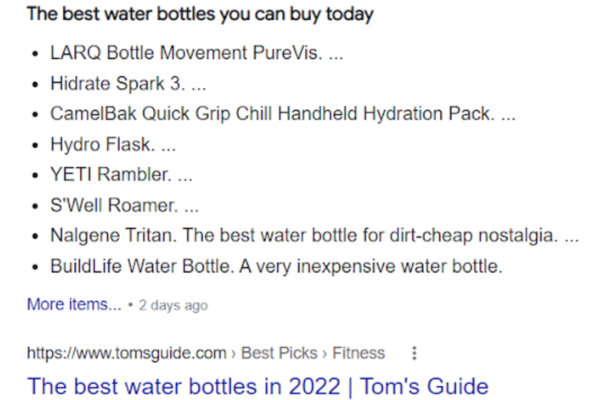The addition of featured snippets to Google results pages represents one of the most significant developments in the evolution of search.
Position zero results—snippets that appear before the main organic listings—have become increasingly prominent. And optimizing for “position zero” can have significant positive effects on your site’s traffic.
Both search engine experts and marketers should build pages with featured snippets in mind. Simple tweaks to your keyword research and content strategies will likely lead to greater brand exposure and more clicks.
This post includes a comprehensive overview of the different types of featured snippets and provides a step-by-step outline of how to increase your chances of appearing in the top position (along with advice about when you might not want to).
Key Takeaways for Marketers and SEOs
- “Zero position” featured snippets have a click-through rate of 35.1%.
- Position one results have a click-through rate of 28.5% if a featured snippet is not displayed at position zero. Position one results on search engine results pages (SERPs) with a featured snippet have a click-through rate of 23.3%.
- Optimizing for position zero is generally a good idea for all types of pages (content, landing pages, about pages, etc.).
- The most important optimization steps are maintaining pages with existing snippets by updating content, identifying suitable keyword opportunities, and creating a “snippet ready” page structure that leverages question-style headings and succinct definitions.
What Are Featured Snippets?
Featured snippets are dedicated sections in SERPs that show extracts from web pages, include a link to the web page underneath the extract, and appear alongside standard organic search results.
Google defines snippets in the following way: “Google’s search results sometimes show listings where the snippet describing a page comes before a link to a page, not after as with our standard format. Results displayed this way are called “featured snippets.”
Position zero results are featured snippets that appear before other results. Rich snippets, which are sometimes confused with featured snippets, are normal results with additional information such as star ratings, pricing, addresses, phone numbers, and so on.
There are five types of featured snippets:
- Extracts: Also called paragraph snippets, these are by far the most common type of featured snippet and consist of single or multi-sentence extracts from web pages.

- Numbered lists: Numbered lists provide extracts from pages in the form of sequential points. They usually describe a process and are commonly served in response to queries beginning with “How to….”

- Bullet-point lists: Bulleted lists provide information in the form of bullet points and are typical for “best of” and “top rated” queries. They provide multiple points of information in a non-sequential and unranked way.

- Tables: Tables contain one or more data points for a list of entries.

- People Also Ask: People Also Ask do not occupy position zero. Users click on FAQ-style dropdowns to reveal answers to questions related to the original search queries. There are no downsides to optimizing for “People Also Ask” because feature sites are not automatically excluded from organic results like with featured snippets.

Not all Google features, such as knowledge panels and short answers without a site citation, are classed as featured snippets. And not all position zero results are featured snippets—top stories, carousels, and recipes are all examples. Sites that appear at position zero are not included in the main search results.
Is Position Zero the End of Search?
The increasing prevalence of featured snippets has led SEOs to ask the question, “Do they herald the end of search?” The short answer is no.
First, featured snippets appear for just above 10% of search queries. Second, even for those SERPs that do include featured snippets, the majority of clicks go to standard organic listings. Finally, tentative research published in early 2022 shows that the presence of featured snippets may actually be decreasing in favor of People Also Ask (PPA) snippets (although the author is keen to stress the continued importance of optimizing for them).
At this stage, the picture is far from clear. But anybody that declares featured snippets constitute “the end of search” shouldn’t be taken seriously.
How to Achieve Position Zero Rankings: 3 Steps
It’s important to note that there’s no standard method for ensuring your content appears in featured snippets.
However, following the steps below ensures the best possible chance of appearing in the much-desired zero position. And even if you apply the guidance below and don’t achieve a featured snippet ranking, the SEO outcomes will still be positive.
1. Maintain Existing Zero Position Rankings
Monitor existing zero position rankings and perform regular updates on your top-performing pages. Regular tracking will also alert you to drops in SERPs. When you lose a position-zero result, you can take action to restore your previous rankings.
Update your content in the following ways to maintain position zero rankings:
- Ensure basic SEO optimization: Before you think about snippet-specific optimization, you should ensure that you’re following basic on-page best SEO practices. Are you using concise URL paths, HTTPS, relevant markup schema, sufficient content length and keyword density, and an easy-to-read, header-based structure?
- Update content regularly: Google prefers to display current content in featured snippets. Ensure that the information you display is up-to-date and mention that the page has been checked recently with a tag along the lines of “Last Updated on….”
- Answer additional related questions: High-quality content often ranks for multiple featured snippets. Consider expanding existing pages with questions and answers related to the core topic.
- Track existing content that ranks highly in standard results: Pages that rank in the top ten “standard” search results, especially those that occupy the first position underneath a featured snippet, should be considered low-hanging fruit. Keep in mind that not all content will qualify for featured snippets. However, if you are able to provide a higher quality answer than the current snippet, it is worth updating the content of your top-performing pages.
Updating content is usually inexpensive but pays large dividends in terms of maintaining traffic, especially for content that drives substantial leads.
2. Create Content for Featured Snippets
Creating content for featured snippets is usually straightforward in the sense that it will likely call for only minor changes to your existing content creation processes. Small tweaks to keyword research and article structure can have significant impacts.
Follow the tips below to optimize content with featured snippets in mind:
- Base content around question queries: Search queries in the form of questions—starting with words like “why,” “how,” “if,” “do,” etc.—typically return featured snippets. Keywords with informational intent are also often served by featured snippets. Create content around these queries wherever possible or, at the very least, dedicate sub-sections to them.
- Create content for search queries that already show featured snippets: Keyword queries that already return featured snippets represent viable opportunities if you’re able to create higher-quality, more detailed content.
- Structure pages in a Q&A format: Weave succinct, definition-style answers into your content and make effective use of headings, with questions as specific sub-headings wherever possible. Match the word structure of headings and answers to search queries to increase relevance. “People also ask” and “People also search for” are valuable tools in this regard.
- Use correct schema markup and follow Google best practices: There is some debate around the role of schema markup in featured snippets, and there are many examples that don’t have structured data. Nonetheless, there are no downsides to including structured data in your pages. Specific examples include lists, FAQs, articles, home activities, “how to” pages, and others.
3. Don’t Be Afraid to Use the Opt Out
In rare cases, zero position snippets underperform compared to top five rankings. Sometimes, drawing people to a landing page will be more important than occupying position zero, especially if brand awareness is not a priority. Similarly, you may wish to show rich snippets in your results, which may not be possible in a featured snippet.
Wherever possible, track conversions before and after achieving a zero position to determine which scenario is better for your web pages. It’s possible to opt out of featured snippets by using the nosnippet tag.
Measuring it all through an Enterprise SEO Platform
Optimizing for featured snippets is an essential part of an effective SEO strategy. It’s a simple but potentially lucrative process. In the vast majority of cases, it will be the best path to take.
However, don’t assume that featured snippets are always the best solution. Sometimes it will be better to rank in standard results, and it’s important to be able to monitor your progress to make sure you’re achieving those listings you’re aiming for. We recommend checking out an enterprise seo platform like BrightEdge to help!
Intent is the main factor at play when it comes to featured snippets and position zero results. Searchers that want a quick answer—“What’s the time in Rio Janeiro?”—won’t go to a site if they don’t have to. It sometimes takes quite a bit of keyword research in a platform to identify and match that intent to the query to see if it makes sense to optimize for.
Other searchers, such as those interested in buying an item or reading an in-depth item, almost always will.
More Resources
